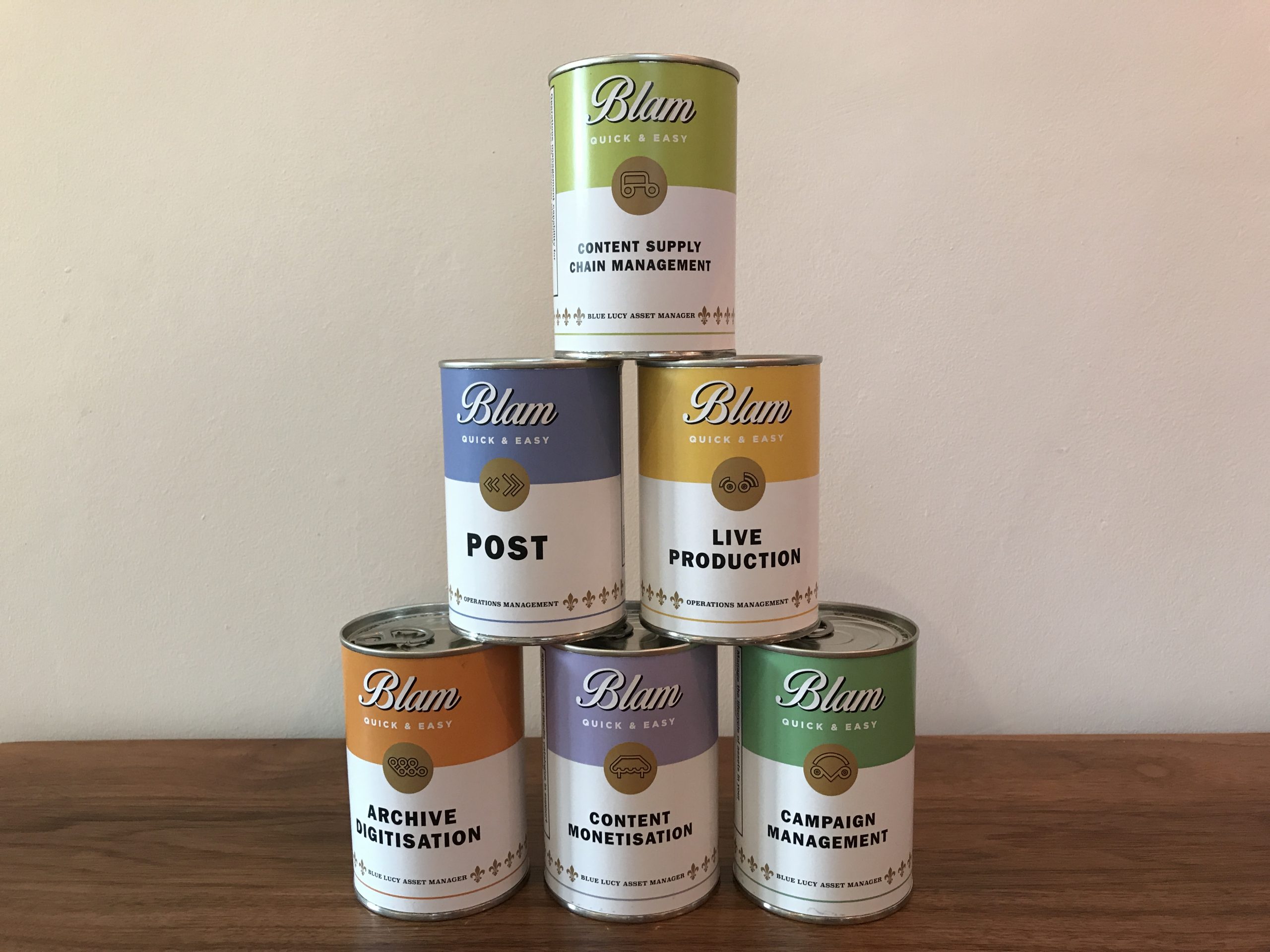







Twenty or more years since digital Media Asset Management systems came into being a MAM implementation for many operators remains a daunting prospect. An off-the-shelf, packaged solution approach reduces time to implementation, minimises financial risk and delivers tangiable operational benefit.
The failure of high-profile initiatives means that, for many, MAM has become synonymous with large capital costs, a painful transition to operational service and, ultimately, unrealised benefits. Deferment of a MAM initiative is all too common and consequently media businesses suffer from inefficient workflows or miss out on new revenue streams.
Equally, many operators consider that the operational issues they face, be it throughput bottlenecks or new business objectives, do not require a big MAM implementation. We agree, and have cooked up BLAM-in-a-Can, an entry level packaged media and workflow management solution.
BLAM-in-a-can provides a quick and easy deployment to suit a range of operations – from content supply chain management to post production. Each package includes a core BLAM complete with the relevant connectors and plug-ins (BLidgets) to support the pre-canned workflow. BLAM-in-a-Can supports existing processes but drives efficiency through automation and task management.
BLAM-in-a-Can will suit many operations out of the can but can grow with your business needs. Additional BLidgets may be added to meet new requirements and long term value for many will come from the migration of services to the cloud.
In addition to BLAM-in-Can we have a number of new workflow BLidgets on show this year. These are largely focused on accessing 3rd party provisioned services as part of a BLAM workflow and demonstrate the openness and flexibility of BLAM.
BLidgets are the building blocks of the Blue Lucy Asset Manager’s workflow capability and enable operators to rapidly build process and task-driven workflows to deliver efficiency. BLidgets provide management control of Blue Lucy plug-ins such as transcode as well as data adaptors and processing connectors to a wide range of 3rd party systems and services. Using BLAM’s new workflow runner, operators can now download, install and even create their own BLidgets to create customised workflows.

It is BLAM-in-a-Can, however, that has caused the most excitement in our marketing department which has created a range of branded cans inspired by the Andy Warhol’s 1962 Campbell’s Soup Can piece -fitting in with our broader pop art themed stand graphics. 300 cans have been produced – including all six ‘flavours’ – but instead of soup, each can is filled with chocolate money representing the value that BLAM can bring to your operation. The chocolate is delicious and will give you that extra energy to get around the ever expanding show. In addition, one lucky visitor will pick up a can containing an Amazon streaming media player – so do stop by 7.G07 and pick up a can of BLAM.

When you have eaten the delicious chocolate money, please do dispose of the can responsibly. Naturally, they are recyclable, but we are also offering a GOPRO HERO Session Action Camcorder for the most innovative re-use. Please post your pics on Twitter using and include #BLAMInaCan and @BlueLucyMedia or email them to enquiries@bluelucy.com
See you in Amsterdam.

Implementing a media management system is considered to be a risky business. Like national infrastructure programmes, the perceived complexity, upheaval and perception of failure can be so daunting that the risk may seem to outweigh the reward. But, like so many business technologies, MAM have been transformed in recent years with the advent of open standards and interfaces.
This blog piece debunks some common MAM myths.
1. Perception: MAM implementation projects cost millions
Truth: MAM software is available from as little as £10k
It’s not surprising that MAM projects are perceived as expensive – before its collapse the notorious BBC Digital Media Initiative had racked up a £96m bill and even comparatively ‘small’ projects at a large facility or national broadcaster in recent years have averaged a few million. For most operators those figures are unimaginable. But a pragmatic approach to scope and implementation can deliver real value at low cost. The principal enabler here is the cost of the MAM software.
Rather than starting at £1m as they did ten years ago the cost for modern product has dropped to around £150k for a base system – with some tools available for as little as £10k. Cloud or hybrid service models make it possible to pay-as-you-go for a fraction of the cost and without long term commitment.
For on-prem’ deployed systems the cost reduction is largely as a result of use of open, service based technology as well as vendors designing the foundation tools to be less specific to a given function or workflow. Modern MAMs are architected on the basis of a core which is functionally augmented with bolt-ons or plug-ins.
2. Perception: MAM’s rarely deliver value on investment
Truth: A targeted approach delivers immediate benefits
The return on an investment of millions will be long – often too long to make a strong business case, but now that MAM system implementations can be achieved for a fraction of the cost, it’s easier to prove real value in day-to-day operations and to the bottom-line.
With relatively inexpensive entry points, operators can focus on a specific difficulty in the operation and prove or refine an approach before tackling other areas in the workflow. Defining and building workflows is no longer time consuming so demonstrating operational benefit may be achieved in hours instead of months.
An important caveat here is scalability though – do ensure that the chosen MAM vendor can scale as you broaden deployment – a modern MAM should readily scale from a few, to a few hundred users without even taking the system off-line.
3. Perception: Implementation of a MAM system takes months – if not years
Truth: You can be up and running in minutes
MAM history is littered with projects that took years to implement and were obsolete by the time they were delivered. This was generally caused by an over-focus on up-front analysis driven by the need to understand the operating model ahead of configuration which itself was driven by the complex and time-consuming nature of configuration.
A modern MAM can be up and running in minutes – or seconds in the case of cloud-based system. From the ‘vanilla’ base an operator can quickly create users, set access permissions and build simple production workflows for transcode and delivery or review and approve. A modern MAM allows operators to build and test workflows as they go – an agile approach which delivers rapid results. Because it is now quick and easy to configure and implement a base system, and then customise the system to your needs, there is less pressure to perform a perfect up-front analysis, and more tolerance for changing requirements.
Some products such as the Blue Lucy Asset Manager (BLAM,) have built-in tools that deliver immediate benefits.For example; BLAM will index existing storage pools and create browse clips without moving the original media and while maintaining project hierarchy. This tool means that projects can automatically be brought under management of the MAM without any user intervention or interruption to operations.
4. Perception: Deploying a new MAM means replacing the systems we have.
Truth: An effective MAM will integrate with legacy and 3rd party systems.
Many MAM projects are initiated on the premise of replacing one or more existing systems. The narrative runs “… we can replace these three systems with this one new system. Operations will be simpler, delivery will be faster, and support will be easier……” This, all too common, one big new universal panacea system mantra rarely (never) actually delivers. Subsuming functionality, particularly in active systems is fraught with risk – risk which always translates to cost. The simplest and most cost effective approach is rarely replacement.
A modern MAM vendor should be able to provide connectors to commonly used 3rd party systems and be willing to build these for legacy components. These connectors are used to get essential data from 3rd party systems, process it and if necessary, put data back. The MAM should be capable of acting as the integration layer that connects systems and, importantly, provides a single view of the operation.
This is far less expensive and risky than incorporating functionality in a new system. It is also likely that specialist systems provide a better, or more specific, capability than one system trying to do everything. Do be wary of vendors who are reluctant to integrate with third parties or boast that their systems can absorb operational capability.
5. Perception: MAMs only manage media.
Truth: Modern MAMs provide broader capabilities including workflow orchestration and enterprise reporting.
Very few modern MAMs are just asset managers, but perversely the term MAM has stuck because it’s one that everyone understands. Rather than just being limited to a static repository where media objects are stored and made accessible, many MAMs include key operational functions such as automatic and task-driven workflows. The automation of tasks such as transcoding in a workflow obviously removes manual process but of equal benefit is a task driven workflow which drives operation procedure – i.e. the people.
More sophisticated systems (like BLAM) can provide data and intelligence on a broadcast / media operation, enabling workflows to be adjusted for maximum efficiency. Efficiency for a content producer translates to saving money in the production or distribution process or reaching wider audiences on an ever increasing number of consumer platforms.
6. Perception: MAM projects require big investments in infrastructure and storage
Truth: Modern MAM’s use the cloud for scalability
Although the cost of MAM software is largely flat (or at least should be,) the cost of storage is dependent on the volume of media being produced and stored. When planning on-prem’ deployments, system designers – understandably – plan for the worst case scenario, which means high storage costs and big CAPEX spend.
Using a combination of on-premise and cloud storage allows media operators to avoid spending money up-front for capacity that they may or may not need in the future. MAM vendors like Blue Lucy are able to seamlessly blend the on-prem’ and cloud-based services, providing access through a single user experience. This approach offers huge flexibility for ‘burst’ capacity and de-risks a strategy of cloud migration.